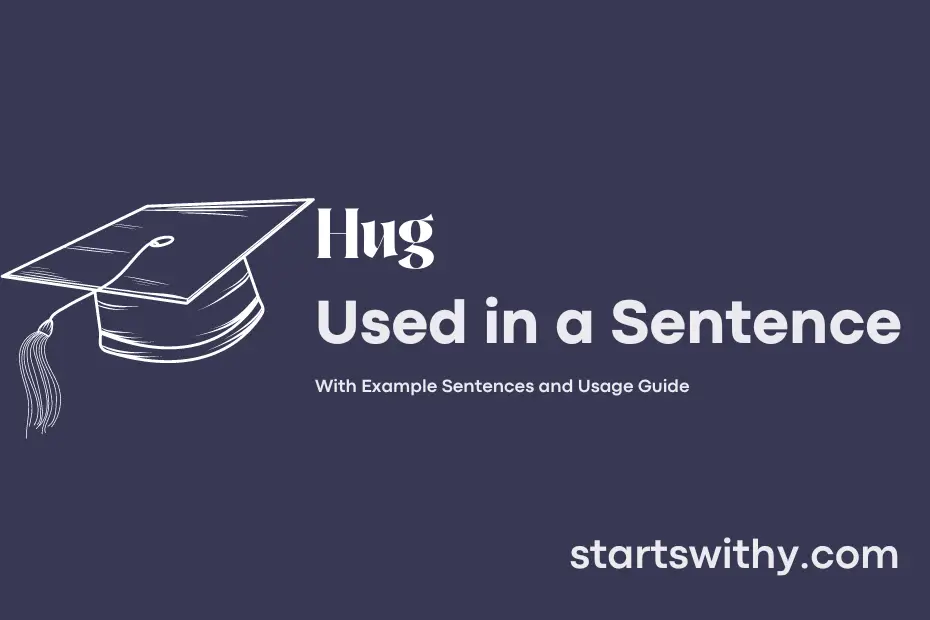Do you know the power of a simple hug? A hug is a gesture of embrace where one person wraps their arms around another, conveying warmth, comfort, and support through physical contact.
Within a single hug, individuals can express a range of emotions such as love, appreciation, sympathy, or congratulations. It has the ability to provide solace during times of sadness, celebrate moments of joy, or simply strengthen bonds between two people.
7 Examples Of Hug Used In a Sentence For Kids
- Hug your teddy bear tightly before going to sleep.
- Ask your friend for a special hug to show you care.
- Your mom is waiting to give you a warm hug after school.
- Whenever you feel sad, remember a hug can make it better.
- Don’t forget to give your pet a big hug when you get home.
- A loving hug can make someone’s day brighter.
- Always be ready to share a hug with someone who needs it.
14 Sentences with Hug Examples
- After a long day of classes, a hug from a friend can make everything better.
- Finals week can be stressful, but a tight hug from a roommate can provide much-needed comfort.
- It’s common to see classmates give each other a quick hug as a form of greeting on campus.
- When feeling homesick, a virtual hug from family members can make a big difference.
- During group study sessions, a supportive hug can boost morale and motivate everyone to keep going.
- Attending college in a different city can be challenging, but the warmth of a goodnight hug can ease the homesickness.
- Celebrating a successful presentation with a group hug can create a sense of camaraderie among classmates.
- A surprise hug from a long-lost friend on campus can bring back cherished memories.
- For international students, a warm Indian hug can help them feel more at home in a new country.
- Exchanging a quick hug before an exam can help calm nerves and provide emotional support.
- Establishing a hugging circle with friends can create a sense of unity and solidarity among college students.
- Attending a college event with live music can lead to spontaneous hugs among classmates caught up in the moment.
- Giving a friend a congratulatory hug for their achievements can leave both parties feeling uplifted.
- College relationships can be strengthened through regular hugs that convey love and affection.
How To Use Hug in Sentences?
Hug is a friendly and affectionate gesture that can convey love, support, and comfort. To use hug in a sentence, start by identifying the subject and object of the sentence. The subject is the person who is giving or receiving the hug, while the object is the person or thing being hugged.
For example, you can say, “I gave my friend a warm hug when they were feeling sad.” In this sentence, “I” is the subject who is giving the hug, and “my friend” is the object who is receiving the hug.
You can also reverse the roles and say, “My friend gave me a tight hug after I won the game.” In this sentence, “My friend” is the subject giving the hug, and “me” is the object receiving the hug.
When using hug in a sentence, it is important to consider the context and tone of the interaction. A hug can be used to express a range of emotions, from joy and excitement to comfort and sympathy. Consider the relationship between the people involved and the emotions you want to convey to determine the appropriate use of hug in your sentence.
Practice using hug in different sentences to become more comfortable incorporating this affectionate gesture into your communication.
Conclusion
In conclusion, the warmth and comfort of a hug can be seen in various aspects of life. From familial embraces to friendly hugs, the power of physical touch to convey love and support is evident. Hugs can mend relationships, offer solace during difficult times, and strengthen bonds between individuals.
Whether it’s a simple hug shared between friends or a heartfelt embrace from a family member, the significance of these gestures goes beyond words. They symbolize care, empathy, and connection. In a world where communication is often complex, a hug can serve as a universal language of understanding and compassion, reminding us of the innate need for human connection and the healing power of touch.



